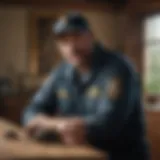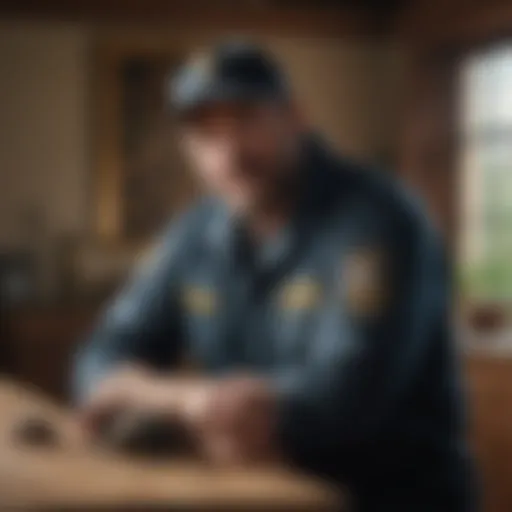Expert Guide: How to Safely Remove Wood Bees from Your Property
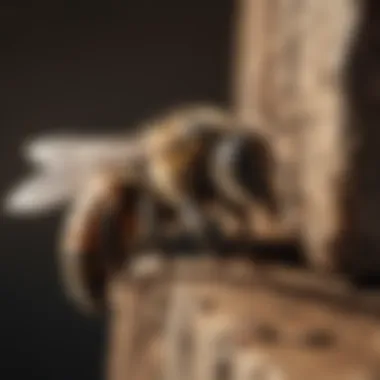

Preventive Pest Control Strategies
When it comes to ensuring a pest-free environment, implementing preventive pest control strategies is paramount. One of the key areas to focus on is securing the exterior of your house. Sealing cracks and crevices not only prevents wood bees from infiltrating your property but also safeguards it against other pests. Clearing debris around your house is crucial as it eliminates potential hiding spots for pests, discouraging infestations. Additionally, implementing measures to prevent pests from entering your house, such as installing screens on doors and windows, can significantly reduce the likelihood of wood bee infestations.
Yard maintenance plays a crucial role in pest control. By following essential yard care routines, such as mowing the lawn regularly and trimming bushes and trees, you can create a less hospitable environment for pests. Implementing methods for keeping your yard pest-free, such as using natural insect repellents or maintaining proper drainage to prevent puddles, can further enhance your pest control efforts.
Maintaining indoor cleanliness is another vital aspect of preventive pest control. By following expert cleaning tips and techniques, such as vacuuming regularly and decluttering storage areas, you can minimize potential hiding spots for pests and reduce the risk of infestations. Creating a pest-resistant indoor environment involves storing food in airtight containers, fixing leaky pipes promptly, and sealing cracks or gaps around the house to prevent pest entry.
Efficient waste disposal is a critical component of pest prevention. By adopting proper garbage disposal methods, such as keeping trash bins tightly sealed and emptying them regularly, you can eliminate food sources that attract pests like wood bees. Emphasizing the importance of proper garbage disposal to all household members can help maintain a clean and pest-free environment.
In addition to these key strategies, exploring innovative ways to safeguard your home against pests, such as using natural repellents like mint or lavender plants around your house, can contribute to a comprehensive pest control approach.
Introduction
Wood bees, also known as carpenter bees, can be a nuisance for homeowners, causing structural damage to wood surfaces. In this comprehensive guide on removing wood bees, we will delve into the essential steps to effectively address wood bee infestations. Understanding the behavior and characteristics of wood bees is crucial to successful removal and preventing future infestations.
Understanding Wood Bees
Wood bees are solitary insects that resemble bumblebees but are known for their distinctive behavior of tunneling into wood to create nests. These insects are attracted to untreated or weathered wood, making wooden structures susceptible to infestation. Understanding the life cycle, nesting habits, and identifying features of wood bees is essential for efficient removal.
Importance of Removing Wood Bees
The importance of removing wood bees cannot be overstated, as their presence can lead to extensive damage to wooden structures over time. By burrowing into wood, wood bees weaken its integrity, posing a risk of structural compromises. Additionally, their nesting habits attract other wood-boring insects, exacerbating the damage. Removing wood bees promptly not only protects your property but also ensures the safety and longevity of wooden surfaces.
Identification of Wood Bees
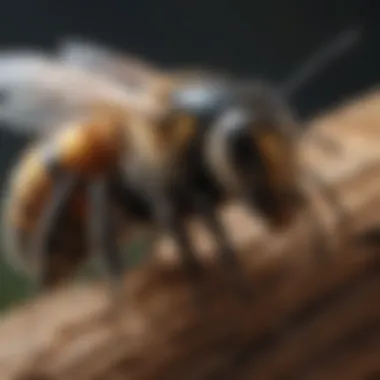

Physical Characteristics
Wood bees, also known as carpenter bees, are robust insects with a shiny black abdomen and fuzzy yellow thorax. They resemble bumblebees but have a bare, shiny abdomen instead of a hairy one. Their size ranges from 1/2 to 1 inch in length. An essential physical characteristic of wood bees is their habit of burrowing into wood to create nests, causing structural damage over time.
Behavioral Patterns
Wood bees exhibit unique behavioral patterns that set them apart from other bee species. These bees are solitary insects, unlike the social honeybee, preferring to nest individually as opposed to in colonies. The female wood bee is responsible for excavating nests in wood, creating tunnels where they lay their eggs. Understanding this behavior aids in locating and addressing wood bee infestations effectively.
Identifying wood bees based on their physical appearance and behavior is key to implementing targeted removal strategies and preventing future infestations. By recognizing these distinctive traits, homeowners can take proactive measures to safeguard their properties from wood bee damage.
Locating Wood Bee Nests
In the broader scope of exterminating wood bees from your property, the crucial step of locating their nests plays a pivotal role in effectively eradicating these pesky invaders. Understanding where wood bees establish their nests is not just about addressing a current infestation but also about thwarting potential future invasions. By honing in on the specific areas where wood bees congregate to build their nests, homeowners can proactively take steps to eliminate these nests and prevent their recurrence.
When it comes to pinpointing wood bee nests, precision is key. These industrious insects tend to nest in unpainted or weathered wood, preferably exposed to sunlight, as it offers an ideal environment for their breeding endeavors. Thus, examining surfaces such as eaves, decks, fences, and any exposed wooden structures becomes imperative during the initial stages of inspecting your property for wood bee activity. Moreover, paying attention to signs like sawdust piles beneath entry holes or an audible buzzing sound emanating from potential nesting sites can provide valuable clues for locating nests.
Additionally, the strategic spotting of wood bee nests is essential for determining the appropriate removal method. Locating these nests enables homeowners to tailor their removal approach based on factors like nest accessibility, size, and proximity to sensitive areas. By meticulously identifying the exact locations of these nests, individuals can not only streamline the removal process but also mitigate any potential risks or damages that may arise during the eradication efforts.
Furthermore, the act of pinpointing wood bee nests serves as a proactive measure in safeguarding your property from structural harm caused by these wood-boring insects. By promptly identifying and eliminating nests, homeowners can prevent the deterioration of wooden structures and avert costly damages that may arise due to prolonged wood bee infestations. Therefore, the significance of locating wood bee nests extends beyond mere eradication; it acts as a preemptive measure to maintain the integrity and longevity of your property's wooden components.
Preparation for Removal
In the process of removing wood bees from your property, adequate preparation plays a crucial role in ensuring a successful and efficient outcome. By focusing on the topic of Preparation for Removal, this article aims to highlight the significance of this phase and provide insights into specific elements, benefits, and considerations that can contribute to a smooth wood bee elimination process.
Gathering Necessary Tools


When it comes to addressing a wood bee infestation, having the right tools at your disposal is paramount. Proper tools not only facilitate the removal process but also ensure your safety and effectiveness. Essential tools for removing wood bees include protective gear such as gloves, goggles, and a mask to shield yourself from potential bee stings and exposure to chemicals. Moreover, tools like a flashlight, caulk gun, sealant, and a bee vacuum are indispensable for locating and extracting bee nests with precision. Adequate preparation in terms of tool gathering minimizes disruptions during the removal process and enhances overall efficiency.
Protective Measures
Prioritizing protective measures is fundamental when preparing for wood bee removal. Apart from having the necessary tools, it is crucial to consider safety precautions to safeguard yourself and others during the removal process. Wearing appropriate protective gear, such as thick clothing, closed shoes, and gloves, shields you from bee stings and potential allergic reactions. Additionally, using a bee suit or beekeeper's attire provides an extra layer of protection against aggressive bees. Implementing protective measures not only ensures your well-being but also contributes to a smooth and incident-free wood bee removal operation.
Removing Wood Bees Safely
In the comprehensive guide on how to remove wood bees, the section on Removing Wood Bees Safely holds vital importance. Ensuring the safe removal of wood bees is crucial not only for effectively getting rid of the pests but also for maintaining a secure environment for your property. This segment focuses on using methods that do not harm humans, animals, or the environment while effectively eliminating wood bees. The safety aspects considered in this section aim at providing a solution that is both efficient and environmentally conscious.
Non-Lethal Removal Methods
Using Citrus Sprays
Exploring the realm of Non-Lethal Removal Methods, Using Citrus Sprays emerges as a standout approach in the fight against wood bees infestations. Citrus sprays are known for their natural ingredients that repel wood bees without causing harm to them. The key characteristic of Using Citrus Sprays lies in its eco-friendly composition, making it a popular choice for environmentally conscious individuals dealing with wood bees. A unique feature of Citrus Sprays is their non-toxic nature, ensuring the safety of other beneficial insects in the vicinity. While advantageous in being safe for the environment, one disadvantage is that it may require more frequent application compared to chemical alternatives.
Deploying Vacuum Techniques
Another effective method under Non-Lethal Removal Methods is the deployment of Vacuum Techniques to eliminate wood bees. Vacuuming the bees allows for their removal without harming them, providing a humane approach to pest control. The key characteristic of Vacuum Techniques is their non-invasive nature, making them a popular choice for those seeking non-lethal solutions. A unique feature of this method is its ability to capture bees without dispersing harmful chemicals in the environment. While advantageous in being non-toxic and safe, a potential disadvantage is the need for careful handling to avoid bee stings.
Lethal Removal Methods
In cases where Non-Lethal Methods prove ineffective, resorting to Lethal Removal Methods becomes a necessary step in eradicating wood bees.
Insecticidal Dust Application
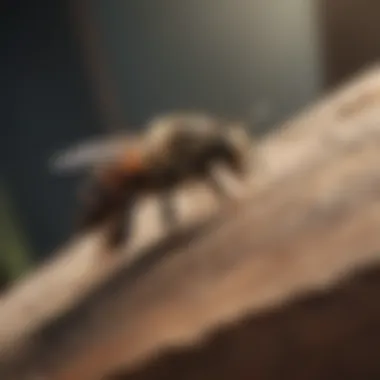

Among the Lethal Removal Methods, Insecticidal Dust Application stands out as a powerful solution in combating stubborn wood bee infestations. The key characteristic of this method lies in its efficiency in killing wood bees upon contact, providing a quick resolution to the issue. The unique feature of Insecticidal Dust Application is its long-lasting effects, ensuring continued protection against wood bees. While advantageous in its potency, a disadvantage is the potential harm it may pose to other beneficial insects.
Professional Extermination Services
When facing extensive or challenging wood bee infestations, seeking Professional Extermination Services becomes a viable option. Professional services offer expertise and specialized tools to effectively remove wood bees from your property. The key characteristic of such services is their guaranteed results, giving you peace of mind that the infestation will be thoroughly dealt with. A unique feature of Professional Extermination Services is their comprehensive approach, addressing not only current infestations but also implementing preventive measures for future protection. While advantageous in their effectiveness, a potential disadvantage may be the higher cost associated with professional assistance.
Post-Removal Measures
Post-removal measures play a crucial role in ensuring the effectiveness of wood bee eradication. Once the wood bee nests have been removed, it is essential to focus on sealing wood surfaces and implementing preventive measures to prevent future infestations. These post-removal steps are vital in maintaining a pest-free environment and protecting your property.
Sealing Wood Surfaces
Sealing wood surfaces is a fundamental post-removal measure that helps in closing off any potential entry points for wood bees. By sealing cracks, crevices, and holes in wooden structures, you can effectively deter wood bees from reinfesting your property. Use high-quality sealants or caulking materials to ensure a durable barrier against these pests.
Implementing Preventive Measures
Preventive measures are essential to safeguard your property against future wood bee infestations. Two key aspects of preventive measures include Wood Treatment Techniques and Regular Inspection Practices:
Wood Treatment Techniques
Wood Treatment Techniques involve the application of insecticidal solutions or coatings on wooden surfaces to repel wood bees. This method not only protects the wood from infestations but also acts as a deterrent for potential pests. By choosing the right wood treatment products, you can ensure long-lasting effectiveness and preservation of your wooden structures.
Regular Inspection Practices
Regular Inspection Practices are critical in identifying early signs of wood bee activity and addressing them promptly. By conducting routine inspections of wooden areas, such as eaves, decks, and fences, you can pinpoint potential nesting sites and take preventive action. Regular inspections help in fortifying your defenses against wood bees and maintaining a pest-free environment for the long term.
Conclusion
In wrapping up this insightful guide on how to remove wood bees, it is evident that addressing wood bee infestations requires a methodical and well-executed approach. This article has delineated each crucial step, from understanding the physical characteristics and behavioral patterns of wood bees to locating their nests and preparing for their safe removal. By outlining both non-lethal methods such as using citrus sprays and vacuum techniques, as well as lethal methods like insecticidal dust application and professional extermination services, readers are equipped with a comprehensive toolkit to tackle wood bee issues effectively.
Furthermore, the post-removal measures discussed, including sealing wood surfaces and implementing preventive techniques like wood treatments and regular inspections, underscore the essential need for thoroughness in ensuring a pest-free environment. The significance of these measures cannot be overstated, as they not only eradicate existing infestations but also serve as proactive defense mechanisms against future wood bee encounters.
Moreover, the relevance of this guide extends beyond mere removal procedures; it delves into the importance of fostering a harmonious coexistence with nature. By opting for non-lethal removal methods when feasible and prioritizing preventive measures, individuals can minimize environmental impact and preserve ecological balance. This holistic approach underscores the ethical responsibility that accompanies pest management, advocating for sustainable practices that safeguard both property and biodiversity.


